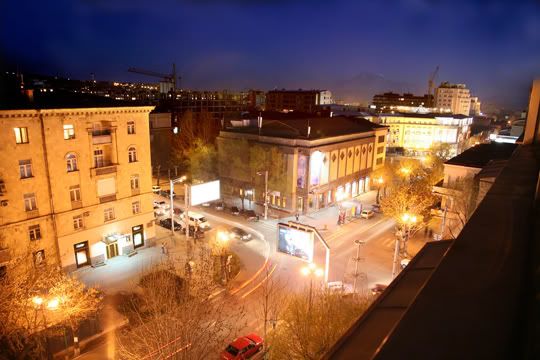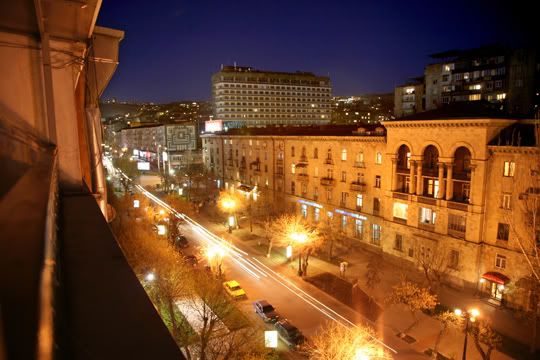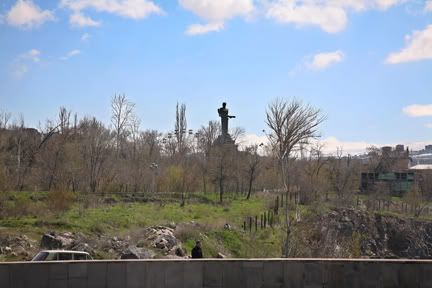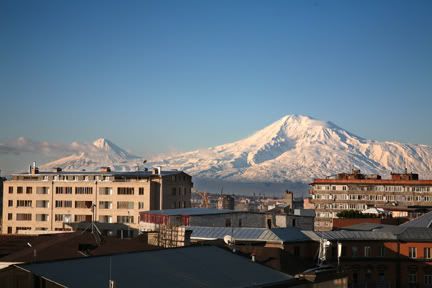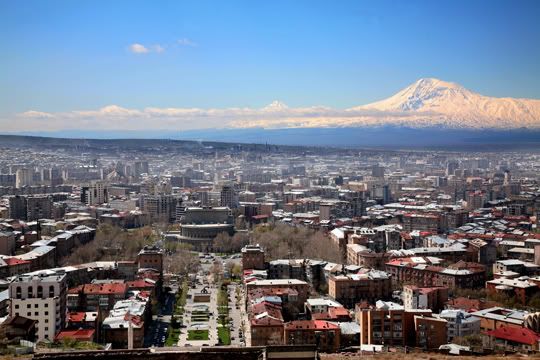HISTORY
Archaeological evidence indicates that a military fortress called Erebuni (Էրեբունի) stood on Yerevan's site as far back as the 8th century BC. Since then the site has been strategically important as a crossroads for the caravan routes passing between Europe and India. It has been called Yerevan since at least the 7th century A.D., when it was the capital of Armenia under Persian rule.
Due to its strategic significance, Yerevan was constantly fought over and it passed back and forth between the dominion of Persia and the Ottomans for centuries. In 1827 it was taken by Russia and formally ceded by the Persians in 1828. After the 1917 Russian revolution it enjoyed three years as the capital of independent Armenia, and in 1920 became the capital of the newly formed Armenian Soviet Socialist Republic, a territory of the Soviet Union. With the collapse of the Soviet Union, Yerevan became the capital of the independent Republic of Armenia in 1991.
Armenia was for most of its history a rural society, with few cities of its own. The modern city of Yerevan was built on tragedy and dreams. Little more than a garrison town of mud-brick and gardens before its first brief experience as capital of an independent Armenia in 1918, the city burgeoned under Soviet rule. The flood of refugees from the 1915 holocaust and its aftermath fueled an uneasy but productive alliance between Armenian nationalism and Soviet hopes of spreading the Communist gospel through the Armenian Diaspora. Modern Yerevan was built, deliberately, to be the universal center and pole of attraction for the diaspora, with an educational and cultural infrastructure far out of proportion to the size or intrinsic wealth of Soviet Armenia.
In 1988, when the collapse of the Soviet Union became visible, Yerevan was a full-fledged, booming Soviet city of over 1 million people. A gracious street plan of parks, ring-roads, and tree-lined avenues had been laid out by the architect Alexander Tamanyan and his successors in the 1920s and 1930s for a population they dreamed might reach 200,000. That goal long surpassed, the process of expansion to reach the magic million-person threshold that qualified Yerevan for a metro and the other perquisites of a city of all-Union importance involved Armenia's successive First Secretaries in sordid expedients and half-finished, earthquake-vulnerable construction projects in sprawled, depressing suburbs.
The success of the 1988 independence movement dealt the city a series of major shocks, first with the forced emigration of a centuries-old Muslim (mostly Azerbaijani Turkish) population, and its replacement by newly impoverished refugees from Baku. The disastrous collapse of the Soviet economic system (Armenia made high-tech pieces of everything, but produced all of practically nothing) triggered the economic migration of hundreds of thousands of impoverished Armenians bound for the bright lights of Moscow or Glendale, California. A reliable census took place in 2001, counting just over 3 million heads in the country.
The city of Yerevan preserves little of its early history in a form of interest to casual visitors. Behind the anonymous Soviet facades, however, a rich and complex life took place and still does, in the bak (courtyard) or in private apartments far better furnished -- with books, musical instruments, art, and hospitality - than 70 years of official culture or a decade of grim poverty would suggest.
Due to its strategic significance, Yerevan was constantly fought over and it passed back and forth between the dominion of Persia and the Ottomans for centuries. In 1827 it was taken by Russia and formally ceded by the Persians in 1828. After the 1917 Russian revolution it enjoyed three years as the capital of independent Armenia, and in 1920 became the capital of the newly formed Armenian Soviet Socialist Republic, a territory of the Soviet Union. With the collapse of the Soviet Union, Yerevan became the capital of the independent Republic of Armenia in 1991.
Armenia was for most of its history a rural society, with few cities of its own. The modern city of Yerevan was built on tragedy and dreams. Little more than a garrison town of mud-brick and gardens before its first brief experience as capital of an independent Armenia in 1918, the city burgeoned under Soviet rule. The flood of refugees from the 1915 holocaust and its aftermath fueled an uneasy but productive alliance between Armenian nationalism and Soviet hopes of spreading the Communist gospel through the Armenian Diaspora. Modern Yerevan was built, deliberately, to be the universal center and pole of attraction for the diaspora, with an educational and cultural infrastructure far out of proportion to the size or intrinsic wealth of Soviet Armenia.
In 1988, when the collapse of the Soviet Union became visible, Yerevan was a full-fledged, booming Soviet city of over 1 million people. A gracious street plan of parks, ring-roads, and tree-lined avenues had been laid out by the architect Alexander Tamanyan and his successors in the 1920s and 1930s for a population they dreamed might reach 200,000. That goal long surpassed, the process of expansion to reach the magic million-person threshold that qualified Yerevan for a metro and the other perquisites of a city of all-Union importance involved Armenia's successive First Secretaries in sordid expedients and half-finished, earthquake-vulnerable construction projects in sprawled, depressing suburbs.
The success of the 1988 independence movement dealt the city a series of major shocks, first with the forced emigration of a centuries-old Muslim (mostly Azerbaijani Turkish) population, and its replacement by newly impoverished refugees from Baku. The disastrous collapse of the Soviet economic system (Armenia made high-tech pieces of everything, but produced all of practically nothing) triggered the economic migration of hundreds of thousands of impoverished Armenians bound for the bright lights of Moscow or Glendale, California. A reliable census took place in 2001, counting just over 3 million heads in the country.
The city of Yerevan preserves little of its early history in a form of interest to casual visitors. Behind the anonymous Soviet facades, however, a rich and complex life took place and still does, in the bak (courtyard) or in private apartments far better furnished -- with books, musical instruments, art, and hospitality - than 70 years of official culture or a decade of grim poverty would suggest.
